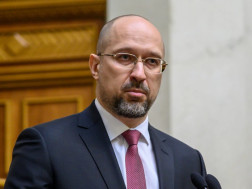PMC Research published a report on Ukraine’s Monetary Stability: Monetary and Exchange Rate Policy. According to the report, since Russia’s invasion of Ukraine on 24 February 2022, Ukraine has adopted various measures and policies to support business and economic activities in the country. Alongside fiscal policies as well as business and labor support programs, monetary regulations have played a crucial role in ensuring the resilience of its wartime economy. The National Bank of Ukraine (NBU) has been efficiently responding to monetary developments, implementing effective actions to maintain the country’s monetary stability. This bulletin provides an overview of some of the most recent monetary and exchange rate policies adopted in Ukraine, and analyzes their effectiveness by looking at three key monetary stability indicators: exchange rate, inflation, and reserves.
Exchange rate regime
The outbreak of the war prompted the NBU to introduce restrictions on foreign exchange transactions and impose strict capital controls in Ukraine. Importantly, the restrictions included the replacement of a floating exchange rate system with a fixed UAH/USD exchange rate. The major difference here is that a floating exchange rate system allows currency values to fluctuate based on market forces, while a fixed exchange rate requires governments or central banks to actively manage their national currency’s value by intervening in the foreign exchange market. The selected system has significant implications for monetary stability and economic policy as a whole. For example, fixed exchange regimes are associated with certain tradeoffs defined by the widely accepted concept in economics known as the impossible trinity, according to which a country cannot simultaneously have a fixed foreign exchange rate, free capital movement, and an independent monetary policy.
In Ukraine, the fixed exchange rate system has primarily been used to purchase foreign currency needed for critical imports and certain military supplies. This fixed exchange rate went unchanged for five months until on 21 July 2022, it was increased by 25% to 35.57 UAH/USD. At the same time, the exchange rate at which banks sell foreign currency, as well as the rate for card transactions abroad were allowed to float.
These steps enabled the prevention of panics and ensured the stable functioning of the financial system. Yet, alongside the benefits, a fixed exchange rate regime has its drawbacks, as shown by the experience of Ukraine itself. In particular, the effects of the currency crises of 2008 and 2014–2015 were substantially aggravated by the long-term fixing of the exchange rate. Specifically, the fixed exchange rate led to the accumulation of foreign exchange imbalances, depletion of international reserves, and the risk of a forced deep devaluation, contributing to economic instability due to a lack of the flexibility needed to adjust to changing economic conditions.
After the 2014–2015 crisis, the NBU switched to a floating exchange rate regime which had a positive effect, bringing flexibility, avoiding FX imbalances and crises, while allowing the UAH to fluctuate in response to market trends, contributing to a relatively stable exchange rate and steady accumulation of international reserves by the NBU.
Drawing from this experience, in July 2023, the NBU published the “Strategy for easing FX restrictions, transition to greater exchange rate flexibility, and return to inflation targeting.” 2 Following this strategy, on 2 October 2023, the NBU announced that it was abandoning the fixed exchange rate regime and switching to a managed exchange rate flexibility regime. The latter was imposed on account of the limitations presented by full-scale war, which has led to persistent shortages of foreign currency in the market. Unlike a fully floating exchange rate, this approach allows the NBU to manage the UAH’s value, permitting both weakening and strengthening as needed, while initially setting significant limitations on exchange rate movements in both directions. As a result of this change, the official exchange rate had strengthened to 36.14 UAH/USD as of 4 December 2023, and the cash market rate revalued: 37.35-37.85UAH/USD.
It is important to note that when Ukraine fixed its exchange rate against the USD, the value of UAH was directly tied to the USD at a specified rate. Thus, fluctuations in the exchange rate between the UAH and other currencies depended on the movements of the USD against those currencies. Data on the UAH’s exchange rate with respect to other currencies, namely EUR, GBP, and CHF, demonstrate that fixing the UAH to the USD led Ukraine’s national currency to remain relatively stable against these other currencies from the beginning of the war onwards. To be precise, after an initial spike in 2022, its rates have been stable in 2023. In particular, the UAH/EUR rate stayed between 39.07-40.43 from January 2023 until October 2023, and the UAH has appreciated further against the EUR to 38.56 in November 2023, since managed exchange rate flexibility regime was imposed. Similarly, the UAH/CHF exchange rate has remained between 39.55- 41.82, and the UAH/GBP rate has hovered between 44.26-47.07 in the course of 2023 so far.
The stability in the Ukrainian national currency’s exchange rates, aided by the managed flexibility regime introduced by the NBU, has helped to maintain some degree of price stability. The departure from a fixed exchange rate system has brought relative control to the economic environment, as is evident in the limited fluctuations of the UAH against major currencies. Importantly, however, the stability in the exchange rates has had some mitigating effects on inflationary pressures.
In October 2023, Ukraine experienced a noteworthy slowdown in inflation, as the rate dipped to 5.3% year-on-year (YoY), down from 7.1% YoY in September 2023. Looking at a broader timeframe, Ukraine underwent hyperinflation when the war began in February 2022, leading to a double-digit inflation rate. However, in the second half of 2023, the inflation rate started to decrease, returning to pre-war levels.
Notably, core inflation, which is particularly influenced by the prices of clothing and footwear, has exhibited a more pronounced deceleration than initially anticipated by the NBU. In 2023, core inflation decreased to 6.8% YoY in October, down from 8.4% YoY in September, propelled by alleviated pressure from business costs, sustained stability in the FX market, and optimized production and supply chains. The overall moderation of inflation has been attributed to the expanded supply of food products and the NBU’s commitment to ensuring the attractiveness of UAH assets, coupled with its active participation in the FX market.
As inflation began to ease, the NBU made a significant decision to reduce its key policy rate to 16% (from 20%), effective from the end of October. The NBU maintained a tight monetary policy in the first year or so of the Russia-Ukraine war, with the key policy rate set at 25%. However, the process of lowering this began in June 2023.
The October cut brings the key policy rate in line with the rate for overnight certificates of deposit (CDs), marking a strategic shift in the operational design of the NBU’s monetary policy. Notably, interest rates for other NBU transactions with banks will remain unchanged, thereby maintaining stability across the financial landscape. In essence, these shifts in the monetary policy’s operational design empower the NBU to navigate through economic dynamics effectively, while meeting the immediate need for instrument attractiveness while positioning itself to achieve sustained economic resilience as well, aligning with the broader goal of fostering a monetary environment that supports moderate inflation and exchange rate stability throughout the forecast horizon.
International Reserves
Ukraine’s international reserves stood at USD 38.97 billion in November 2023, marking a 1.9% decline compared to October 2023. The decrease was attributed to NBU interventions and FX debt repayments, which were partially offset by international aid.
In October 2023, the NBU engaged in the net sale of USD 3,338 million on the FX market (sales of USD 3,351 million and purchase of USD 14.0 million) to reinforce Ukraine’s international reserves. The interventions were predominantly triggered by a surge in demand during the initial days of transitioning from a fixed exchange rate to managed exchange rate flexibility system. For the period from October 2 to October 6, the NBU’s net FX sales amounted to USD 1,152 million, nearly half of which was divested by the NBU on the inaugural day of the new exchange rate regime. Subsequently, NBU interventions brought the sort of stability observed before the transition to manage exchange rate flexibility.
Conclusion
Since Russia’s invasion of Ukraine in February 2022, the NBU has implemented a series of measures to support the country’s economy. Initially, the NBU introduced a fixed exchange rate system to stabilize the financial system during the war. However, this approach, while effective in the short term, comes with costs that would outweigh the benefits in the long term.
Recognizing this, in July 2023, the NBU shifted to a managed flexibility regime, allowing controlled fluctuations in the UAH’s value. This strategic move, coupled with active interventions and a commitment to instrument attractiveness, contributed to a stable exchange rate, a noteworthy slowdown in inflation, and a subsequent reduction in the key policy rate. Despite a decline in international reserves in November 2023, the NBU’s comprehensive approach is successfully addressing economic challenges and enhancing resilience.
















